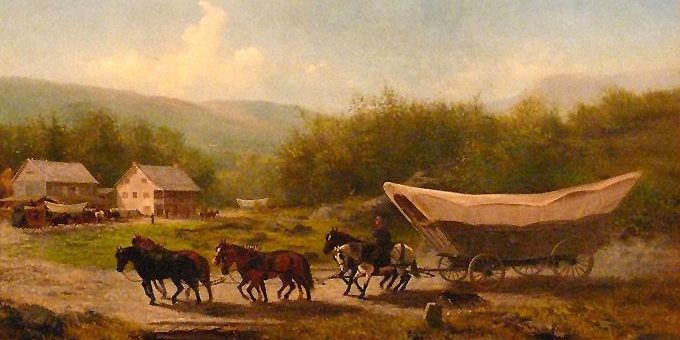
Writing on this topic resulted from email exchanges between General Meagher Division’s Bob Fitzgerald and me. Bob’s family dates from this period and region. In February 2021, the Free Lance Star published my article on Irish influences in U.S. history as a prelude to Irish American Heritage Month. I wrote about the origins of “Ulster Irish” and their reasons for immigration and how they established a settlement near Philadelphia and named it ”Donegal”. In furthering the “Ulster Irish” saga, Bob mentioned the Great Wagon Road. I’ve knitted this piece together from articles on the subject found on the Internet.
The Great Wagon Road became a primary route for the early settlers in the Southern United States, especially the Appalachian backcountry. Although a wide variety of settlers traveled southward on the road, two dominant cultures emerged: German and Irish. The Germans from the Rhine River valley found rich farmland in Pennsylvania and worked it to become prosperous. They became known as the “Pennsylvania Dutch” (corrupted Deutsch).
The Ulster Irish were more restless. These clannish immigrants moved further away from Philly and formed what became known as the Appalachian Culture. These Ulster Irish became the dominant fixture in the Appalachians from Pennsylvania to Georgia. They settled in large numbers and their independent spirit, adventurous personalities and restless nature that proved to be most obvious.
They became frontiersmen as The Great Wagon Road passed through southeastern Pennsylvania turning southwest across the Potomac River and into the Shenandoah Valley. From there they traveled along an ancient Indian trail that was not well suited from wagon traffic. In 1744 these colonists were granted the right to build settlements along the trail and in time the Great Wagon Road was improved to handle wagon traffic. The Ulster Irish continued south through the Appalachians to North Carolina, Tennessee and Georgia.
As the Ulster Irish moved southward they brought their culture, art, and music with them. They brought the fiddle needed to play the music for Irish jigs and reels. (and today American bluegrass). Same thing with the smallest version of the accordion, known as the “squeezebox”. It too is used for traditional Irish dance tunes. And then there’s clogging which developed from Irish step dancing called Sean-nós, an older style of traditional solo Irish dance.
Another bit of trivia is the origin of the term “Hill Billy”. As noted, Ulster Irish who settled in Appalachia brought traditional music with them. Many of their songs referred to William of Orange. In the north of Ireland supporters of King William were known as “Billy Boys” and in the North American Appalachian piedmont the nickname soon morphed into “Hill-Billies”.
Attached at this link is a short video of interest
The Heartland Series – Of Orange and Green (The Scots-Irish)
